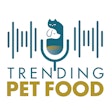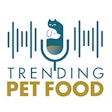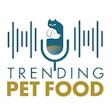
Lindsay Beaton deep dives into microbial ingredients with cofounder and CEO of MicroHarvest Katelijne Bekers to answer why the use of these ingredients in pet foods is important to the future of our planet.
The below transcript is from Episode 62 of the Trending: Pet Food podcast, where host Lindsay Beaton discusses microbial ingredients in pet food with Katelijne Bekers, cofounder and CEO of MicroHarvest. You can find the episode at Trending: Pet Food, on SoundCloud or on your favorite podcast platform. This episode originally aired on May 30, 2024.
We want to thank Cargill for sponsoring this podcast. Cargill, a world leader in pet food ingredients and manufacturing, proudly offers TruMune postbiotic. TruMune is made to help modern pet food brands stand out by supporting multiple trending health claims — like gut health, balanced immunity and pet vitality. Best of all? TruMune benefits are packed into a single, low-inclusion ingredient, and it’s backed by several pet-specific research studies.
Lindsay Beaton – editor, Petfood Industry magazine, and host, Trending: Pet Food podcast: Hello, and welcome to Trending: Pet Food, the industry podcast where we cover all the latest hot topics and trends in pet food. I’m your host and editor of Petfood Industry magazine Lindsay Beaton, and I’m here today with Katelijne Bekers, cofounder and CEO of MicroHarvest. Hi Kate, and welcome!
Kate Bekers, cofounder and CEO of MicroHarvest: Hi, Lindsay, thank you so much for having me on your podcast. It's really an honor.
Beaton: In case you’re not familiar with Kate or MicroHarvest, here’s what you need to know.
Kate founded Microharvest because she had a clear vision for the future of the agri-food supply chain and an intrinsic drive to change the world for the better. As CEO, her dual background in science and business has allowed her to focus on tackling the challenges of the scaling of biotechnological processes and has resulted in an award-winning company, recognized as a pioneer in building a resilient food system for tomorrow by BloombergNEF.
MicroHarvest is a biotechnology company on a mission to drive accessible nutrition for a healthier planet. By utilizing microbial fermentation and agricultural byproducts as feedstock, the company can transform raw materials into high-quality proteins within just 24 hours. Their proprietary technology not only speeds up production but also minimizes the resource footprint compared to traditional protein sources. MicroHarvest's products have applications across multiple industries, from aquaculture to pet and human food.
Kate’s place in a growing alternative protein space, alongside the mission of her company, are why I’ve brought her on today to answer this question: Where do microbial ingredients fit in the future of pet food formulation?
First, Kate, we're going to have to do a little bit of a 101, because you have a lot going on in the alternative protein space. Some of what you're doing is new in terms of ingredients for pet food. I want to start off by asking you -- what is biomass fermentation? And what does it do?
Beckers: So happy to begin at the beginning to explain what we're doing. It sounds very new, but biomass fermentation is a technology that humans have been using even before we knew we were using it. If you consider fermentation processes, this is really the process in which you have foods or sugars or other types of products, and you use microorganisms -- so bacteria or yeast or fungi -- to make another product out of it. I think a product that we all know is bread, where yeast is converting the sugars to CO2, so you get these nice fluffy breads with holes in it. Also well known -- the production of beer and wine, where yeast is converting sugars into alcohol. The same process is what we are using.
It's a little bit different. Instead of using microorganisms as the tool to make the final products, the microorganisms themselves are the products. This is a bit of a different way, but it's very efficient because the microorganisms can grow fast. It's a very fast production system. Also, they are chock full of protein and all kinds of other micronutrients. That way we can produce a lot of very nutritious biomass, a lot of nutritious protein in a very short time just by focusing on growing the microorganisms themselves, and then using those microorganisms as ingredients for your pet foods.
Beaton: How do you grow the microorganisms? Are they feeding on what would normally be the end product and you're using them -- the middle step -- instead of the end step as the actual protein?
Beckers: Yes. If you grow microorganisms, you need to give them some sugar and some nitrogen, and they can produce all the protein and everything of the cell themselves. We call these agrifood side streams. Instead of growing them on table sugar, which we consume ourselves, we grow them on what is left once we have made table sugar from agricultural products.
What's left is still sugar, but we cannot make nice white crystals anymore, so we use that to grow the bacteria. It's sort of a circular process, because we use old products, the waste streams, then the microorganisms grow on that.
We do that in big stainless-steel tanks. In those, we make sure it's the optimal conditions for the microbes to grow. We give them a nice temperature, right pH, then feed them sugar all the time, so that they can grow really well. The benefit of this is you have a tank system, so you can do it anywhere. It doesn't matter if you're on the North Pole or somewhere where it's very hot, because you can really control the environment. You're not dependent on climates or other factors.
Beaton: We're going to talk about its place in food and pet food in a minute, but I also want to know how you got involved in all of this. You cofounded this company. What made you interested in this to begin with?
Bekers: It starts quite a while ago. I started studying biotechnology after high school because of the potential of fermentation and biotechnology. This was a while ago. That was really when the green bioeconomy was starting to turn up. I thought, “this is really amazing, we can move away from polluting the world. Stop using crude oil and use biomass fermentation.”
This is when I started getting into biotechnology – I’m really passionate about the sustainability that it can bring. During my career, I moved more from the science side to the business side of things, because I love biotechnology and I love technology, but I'm not a hardcore scientist. There are other people that are way smarter than me know that I can do the things way better than me.
What I really love is to be on the interface between science and business. If you can bring science into society, this is when everybody can really start benefiting from it. This is the space that I moved to. First, I started working in a company bringing products with industrial biotechnology to market, then I worked in a pilot plant where you scale processes from the lab to large scale -- real bioreactors, which has some implications in biotech.
I really learned the technical side of bringing things out of the lab and into the real world. After that, I went to Germany. There I started working for a company in the B2B ingredients space. I was technical sales in the beginning, so really on this interface between science and business, translating the science for customers.
I really, really wanted to do an executive MBA, because I think if you're on an interface, you need to speak both languages. I could speak with the geeks, but I needed help speaking with the businesspeople. I did an executive MBA, and then moved more to a strategic position in the B2B ingredients space. This was really, really nice, but at some point, it started to itch a bit.
I remembered I started all this to create impacts and to bring something that contributes to the sustainability of the world. I wasn't feeling that was really what I was doing. At that moment, I decided to quit. I called my sister, and I told her, “Okay, I'm going to quit my job. If I don't find anything else, can I live on your couch?” She said, “Yes,” so I quit my job.
Then I started thinking, “Okay, what can I really do? How can I really bring impacts?” I realized that while I was working in the B2B ingredients space, of course, alternative protein has been a hot topic for a long time already. Everybody talks about it. When I was walking from the entrance to the meeting room, you talk about alternative proteins. What I heard several times is that companies are really looking for alternative protein ingredients besides plant-based ingredients, because they have some limitations on nutritional value, on taste, but nothing is available at scale.
If you’re a company and you produce large volumes of pet food, you need large volumes of raw material to be able to even run tests. I had this in mind, and at the same time, I have a background in biotechnology. I know we have these microorganisms, especially the bacteria, that grow really, really fast. They are very, very nutritious. Let's make one plus one equal three.
This is the start of MicroHarvest. How we started really focusing on the very beginning on scalability of the process, which for me also means focusing on using current day equipment and technology out there so that you really can move into the markets relatively fast. That's what we've been doing. The company is three years old, and we have recently done a soft launch of the first products with our protein ingredients in there as introduced together with our partner Factbook. I’m so proud of that -- that we have achieved that in this short period.
Beaton: Why do you think alternative ingredients like this are playing a growing role in the food ingredients space, not just pet food, but in food ingredients overall? What are companies looking for? And what makes microbial ingredients fit in so well?
Bekers: Very good question. I like that you pull it like in the bigger space, the full perspective of everything that we eat and play. I'm not someone that thinks the whole world is going to go vegan in the next decade. I think there's a route to there. We can all agree that the way that we produce our foods, we need to rethink how we do this. There’s a growing world population, the degree of wealth is getting bigger, we're getting more pets. We need more and more prototypical to more and more protein.
The way we produce the protein that we are eating today is not sustainable. If we want to produce more, I always say that we don't have a planet to sit on to eat the protein anymore. We need to move to a different way -- move away from animal-based proteins. There are different solutions for that.
One of them is plant-based proteins, which have been around for a long time and have implemented there. There are limitations to that. As I mentioned, there are limitations on the nutritional value. Of course, the nutritional value of a plant is not the same as from an animal, especially on the protein, the essential amino acids, the balance is a bit difference of some a bit less. The digestibility is a bit less. Plants, they are growing out in nature, they produce antinutritional factors to survive and not be eaten. If we want to use them to eat, you need very efficient systems to be able to do that or really clean the protein out of it.
Then there's also limitations on taste. Of course, what we see, which is for both humans and pets … if you bring them products with only soy protein, at some point, the dogs say, “Ehhh, maybe not.” There's a need for something different out there.
Fermentation is going to play a big role in this. Fermentation is a way to create protein, which is very nutritious. This is possible because of the whole world of microbes – there are a lot of different microbes and you can select the ones that have very good nutritional value, very good amino acid composition, and that are highly digestible. They also don't have these antinutritional factors -- if you pick the right ones -- that plants have; you can use the whole cell as a source. Rather than you must clean out the proteins, so isolate protein from it, then also lose other micronutrients like minerals, vitamins. Everything can stay inside the cell.
The nice thing is you can produce these 24/7, you're not depending on the quality of the soil, how much rain there is, how much sun there is. You can do it always, everywhere, because you control the whole system.
The output is very, very fast. I think we're one of the fastest production systems in the world. Within one day, we can go for sugars to protein. Some processes take three days or one week. If you compare that to work plans, which takes months or an animal, which sometimes takes years, it's very efficient.
It’s really such a smart and such an efficient way to produce protein sources, and other nutritional values. This is really the way to go. We are building on technologies that we already know, it's not something completely new. Yes, on one hand, it's novel, but it uses technologies and microbes that we already know. We’ve known for a long, long time these are safe, because we find them in our foods, we already eat them daily.
We just start leveraging that. That's really what we want to do. We want to leverage what is there in nature, these incredible efficient systems are sometimes called the most efficient protein production factories in the world. They are tiny, but very efficient. Because of this efficiency, this is what we need. We need efficient systems that require less resources, produce less CO2, cause less pollution, use less water, so that we can really create all this protein that the world requires.
Beaton: You mentioned choosing the right microbes for their protein content. Can you, I don't know if “breed” is the right word, but can you breed the microbes for protein? Is it possible the ones you're working with right now, you could increase their protein content sometime in the future or cultivate them so that they can meet different needs in the ingredients space?
Bekers: Yes. There are a couple of different things you can do because the world of microbes is very exotic, very broad. What we specifically use is bacteria, which is one kind. There are also already products in pet foods on the market and in foods that contain yeast. Yeast, fish products. Some microprotein, so based on fungi, the roots of fungi, the roots of mushrooms, actually, and they have bacteria. Bacteria are the tiniest and the most simple ones, but also the most efficient, so this is why I liked it. I like efficiency.
In this space of bacteria, there are millions and millions of different bacteria in nature. I think we only know a couple. What you can do is go into nature, in a place where you know, “Okay, this is a very good environment, or this is a place where animals eat bacteria as a source in the beginning of the food value chain.” You can pick those bacteria and check their composition. If they have antinutritional factors, if they're fully safe -- you can check them and fully analyze them.
Now with the genome technologies, it goes even faster. Then you can see if they are a good source. You can pick different bacteria from different environments -- pick them from the ocean, from foods, from the forest -- you can have different ones. You can analyze the full composition and check, “Okay, this one has a lot of protein with a lot of the essential amino acids. This one has a bit worse profile, so let's focus on this one.”
After they are selected, you can put them in a bioreactor. With the way that you control your process, you can also increase how much protein they have -- if they have lots of protein or a bit less. It's like with humans -- how you feed yourself is also how your own composition is. If you eat only protein, you will have a different body profile then if you eat a lot of fat every day. That’s the thing with microbes – as you grow them, you can choose. That way you can have different nutritional profiles. You can check, “Okay, what's very good for this product, what's really good for food, what’s really good for pet foods, which nutritional profile fits best?”
Beaton: What are some of the challenges you've run into in presenting this ingredient to formulators, either in the human food space or the pet food space? Like we've mentioned, there are several ingredients working in the alternative protein space right now. I feel like the end consumer and the people who are formulating things, they're still trying to wrap their heads around what all these different alternative proteins might do, how they might work and their acceptability with other ingredients and formulations.
You mentioned yeast, and fungi are out there … insect protein, plant proteins. In something like this, where there's so much science behind it, it can probably get technical depending on who you're talking to. What are some of the challenges you've come against in getting people to understand this ingredient or helping them see the possibilities?
Bekers: Good question because it's an important question. If you have an amazing product, but people don't see it, then of course, it doesn't help that you have it. What we've seen so far is a couple of things.
First, it's great to see that pet food producers in general, are open to think about and hear about new ingredients. What you see in the markets is that the amount of pet food that is sold is increasing, the market is growing. Meanwhile, their main raw material source, the meat industry, is not growing at the same rate. They all see a gap coming in their ingredients. They know we need to act, and they're open to exploring new types of ingredients. That’s a great start.
For them, when you offer a very new ingredient that they don't know, they don't know how to formulate with, and they don’t know how to interact with, you will need to help them. That’s very important.
MicroHarvest has done a couple of things to help. First, we hired an animal nutritionist, Ally, and she's brilliant. She did formulate pet foods before, so she really understands how formulation works. She got our products started in the kitchen, trying out -- how does it mix with this? If I mix it with these components, how does it taste? How does it bind? We can help demonstrate how to combine it with high-quality ingredients to give them an insight on where it fits in the formulation.
We also do our own palatability studies to test – are these ingredients attractive? Can you work with it to enhance palatability? Or is it something that you need to mask? We were over the moon because the palatability results are really good. We did the test with treats, with both our product and poultry and some with only poultry, and there's really a strong preference for the ones with poultry and our product. These are things very important for them to know.
Also, because we need to speak to our customers which are the pet food producers, but we also need to think about their customers … we need to think about the end consumers – the pet parents that are going to buy these products. We work together with the university to do consumer research. “This product, how should we address the products? Should it be called single-cell protein? Should it be called microbial protein? How should be presented?” How should these ingredients be explained so they know customers will accept it? From our research, almost 75% of the people after talking about the products, explaining that it's an old product rather than a new one that you can find in your food, in your yogurt, in your pantry. If you explain it like that, there's a very high acceptance to try it both in treats and in complete food.
The name “microbial protein” is one that resonates well, because people really connect it to the microbiome and to heath. If you provide that to the company that’s using your ingredients, this helps them to understand how to formulate with it and how their customers going to respond to it. How should we label it? How can we work with it? It’s very important that you think not just to procurement people or someone in R&D that you're talking to, but you really think on partnering up to bring such products into the market.
Beaton: I want to talk about regulatory for a minute, just because that's always a hindrance for a new ingredient coming out or trying to find your place in all of that. Now you're based in Europe, you're based in Germany. Where does an ingredient like this fall on the regulatory spectrum? Because it's not an animal. It's not a plant. Is there a separate regulatory pipeline for things like this? Or does it fit into somewhere, and what has that process been like in terms of acceptance?
Bekers: Because we tackle different markets, it depends on the market on what the regulatory process is. For the EU, we are now registered on the feed material register, which means that we can sell our products within Europe to the different countries for animal nutrition both for feed and pet foods.
This is not regulatory but more quality, but the production line that we have with our manufacturer has been audited for GMP plus or the quality standard, so everything is order. That allows us to go into the market.
The next step is we want to produce and sell in Europe. Germany and the UK are very big markets, and the biggest one, Spain. Of course, we also want to jump the pond and come your way into the U.S. We are also working through the regulatory approval processes there. We need to get the grant status with the FDA and with AAFCO. We need to make sure that we present all the facts to prove that the product is safe as we have laid out for them, so they can put their stamp of approval. The benefit that we have is one of its strengths is that it's already known for food. That enables us, hopefully, to go through the process a bit faster.
Beaton: Before we talk about the future, and where you think this segment is going to go, I want to know what reception has been like so far. What kind of interest are you getting from pet food companies? Are they more interested in formulating for treats or for complete pet foods? Do they want to use it in combination with other proteins? What are some of the questions you're being asked right now of your customers?
Bekers: Good question. We ourselves have decided to enter the market via treats initially, because we really think with such new ingredients, treats are a good place to start. Also, with palatability, you want something attractive to give your pets their treats, convince them to do tricks and bond with them.
But from customers, there are a lot of requests for complete food. It's very interesting. On one hand, we have requests from a lot of startups or smaller companies that are in the vegan space struggling to find the right vegan ingredients because of the limitation of plant protein. They are like, “oh please, let us test your product. We're very curious because we think it's going to be great.”
But for companies that are using meat-based products, they are not looking at separate, new products, but more to replace part of the meat with our type of ingredients for sustainability reasons and to bring innovation. It's great to see that it's not just the vegan market that is interested, but it's industrywide. It’s very interesting to see and very good to see.
If we talk about the future, there's been a lot of focus on particularly dogs needing to have a meat-based diet because that’s the best for them. At the same time, we find out they’re omnivores and they can do without meat. The industry has been really going to one extreme, and I think now the industry is moving back, which is very good, because our food is not always as good for the planet or our pet. We need to think about it and have our pets take the responsibility in a sustainable world. Now we have proven you can do it, and it can still taste amazing and be incredibly nutritious. It's nice to see that the industry is also making this move and seeing the need for that and implementing new products.
Beaton: From the formulators and the interest that you're getting in them replacing part of their meat protein with this kind of protein -- I've been hearing that a lot with companies who are in the alternative protein space. The vegan companies are going all in, but the meat companies, who might not necessarily be able to or be prepared to completely ax all their meat protein or even looking to do it incrementally in a more sustainable way, even that helps in terms of sustainability for the environment, but also sustainability for the business and for the industry. Do you see a future where this stuff completely replaces meat protein? Or do you feel like in the medium, and even maybe long term, it's going to continue to be a percentage of this, a percentage of that while we figure out what works best and what's most sustainable, not just for the environment, but for the industry and for businesses as a whole? Because it would be very difficult to just completely ax everything we've ever done and go only with these types of proteins while we're still all figuring it out.
Bekers: Whatever you do, I think there's always an optimum. Extremes are always a bit difficult, and maybe sometimes not right. If you think of our food systems, we need to move to a more sustainable space. As I mentioned, I don't think the whole world will go vegan in a decade. There will be animal meat consumption.
If there is animal meat consumption, there will also be rendered meat products. If it's there, better use it then throw it away. That can be nutritious, and if it's the right quality, direct control, it can be used for pet foods. I think this will partly stay, but this also has to do with economics. We are new ingredients. In the beginning, we need to compete with industries which are huge and global. We, as a tiny startup, need to compete with that. We’re not going to compete with the biggest. In the beginning, the different ingredients, whether it's us, whether it's yeast, whether it's insects, we will all find our places in the space and in the different segments, which is going to grow the microbiome space.
I think this is based on the meat industry. I think it will go down. I don't think it will go to zero, but it will go down. Because the alternatives are getting better and better and tastier and tastier, and cost-wise, much more competitive. We can also really bring an edge. The beyond meat industry, because we grow in such a controlled environment, we have a very consistent nutritional profile. It's very easy to formulate, because you don't need to test every batch and adjust your formulation.
We can also bring extra benefits that outweigh other benefits from other sources. It's going to be an interaction within the industry -- learning about the products, working with it, understanding these benefits, then using more and more of it, because they see it's healthy for their products, for the economics. The meat industry will be less and less and less. I don't think it will ever go to zero. Overall, we can make impacts in a sustainable way.
Beaton: You're obviously very passionate about this. You seem to really love what you're doing and what your company is working on for the future of food ingredients. So as a wrap up question, I want to know what makes you most excited about the future of this space and about what you're doing in it?
Beckers: As a CEO, I started this three years ago. This vision that I had has been further built and moved along by the people that joined the company. It’s nice to see the speed we can move this and bring this to market -- what openings, especially in pet food, there is to start testing it, playing with it, implementing it. I think that's so exciting.
It’s not only exciting, but also very necessary. If you develop things slowly, and in 10 years, maybe it's going to come to market -- we don't have the time. We need to start doing it now. This is really what our ambition is – to be at the forefront and make sure that we start tomorrow switching to these types of sustainable proteins. It’s necessary. It’s exciting to see that it's working, and that if you have the right approach, you can move fast.
I don't always have a lot of patience. It's good to see things moving fast. It's exciting to see the timing is so right because there's economical drivers, there's supply chain risk. There are other drivers out there, and everybody understands that to have solutions for those, we need to include sustainability as a basis, as a solution for those challenges. We can be there. We are there. And we're ready to go. So that's very, very exciting to see that it's really happening.
Beaton: This has been a fascinating conversation, Kate, so thank you for coming on the show. Alternative proteins in pet food are a hot topic right now, and learning about some of the research and newer options out there has been one of my favorite parts of the trend. Before we go, let’s do a little plug. Where can people find more information about you and MicroHarvest?
Bekers: The best space to go to is our website microharvest.com. You can also always shoot us a message; it goes to our colleagues, and they will pick it up. If you have any questions on the products beyond what's already on the website or if you want samples, feel free to reach out because we love connecting and helping with those questions.
Beaton: Thank you so much. That's it for this episode of Trending: Pet Food. You can find us on petfoodindustry.com, SoundCloud or your favorite podcast platform. You can also follow us on Instagram @trendingpetfoodpodcast. And if you want to chat or have any feedback, I'd love to hear from you. Feel free to drop me an email: [email protected].
And of course, thanks again to our sponsor, Cargill. This world leader in pet food ingredients and manufacturing proudly offers TruMune postbiotic. TruMune is made to help modern pet food brands stand out by supporting multiple trending health claims — like gut health, balanced immunity and pet vitality. Best of all? TruMune benefits are packed into a single low-inclusion ingredient, and it’s backed by several pet-specific research studies.)
Once again, I'm Lindsay Beaton, your host and editor of Petfood Industry magazine, and we'll talk to you next time. Thanks for tuning in!



















